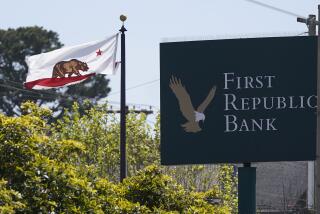AIG’s ace
- Share via
Here’s a riddle for you: How did a flailing American International Group persuade the Federal Reserve to throw it a lifeline two days after the feds snubbed a sinking Lehman Bros.? Answer: by failing on a much, much grander scale.
Both companies were big players in the market for credit default swaps, an unregulated form of private insurance that guards companies against loss when an investment goes bad. But AIG sold more swaps to more banks and investment companies than Lehman did. These extensive entanglements led the Fed to worry that a sudden AIG bankruptcy could drag down much of the financial industry.
Unfortunately, the message to Wall Street seems to be that doing business with a really big firm is virtually risk free, thanks to the likelihood of a federal bailout. The rescue isn’t helping AIG shareholders :AIG -- the stock is worth about $2 a share, down more than 90% from a month ago. But by keeping AIG afloat with an $85-billion loan, the Fed provided a crucial respite for the companies that bought swaps from AIG, along with the company’s bondholders.
It’s worth remembering that AIG, the world’s largest insurance company, didn’t get in trouble for covering risky drivers or storm-damaged homes. State insurance commissioners say that the consumer insurance subsidiaries of AIG were in good shape, and policyholders wouldn’t have been hurt even if the parent company had gone belly up. The company’s turmoil was caused by the guarantees it provided for risky mortgage-related securities. Sound familiar? Those securities triggered the fall of Bear Stearns and Lehman Bros. too. And thanks to the Fed’s bailout, the banks and investment companies that actually held those securities won’t have to raise cash suddenly to offset a precipitous drop in their investments’ value.
Those firms are the real beneficiaries of the Fed’s rescue. It’s clear that a collapse by AIG would have taken a toll throughout the industry, which could have forced a scramble for capital that would tighten credit markets. And that, in turn, might have made it harder for many companies to obtain the money they need to run their businesses. How many more companies would have toppled? Policymakers couldn’t predict and didn’t want to find out.
Before such interventions become habit-forming, there need to be more safeguards -- not for investors but for taxpayers. We’re all for unfettered financial innovation, as long as the industry has a mechanism to limit systemic threats without the central bank’s help. That’s not the case today, obviously. As we said after Lehman sank, the federal government needs better tools to ensure that companies like AIG can’t threaten the entire system when they put themselves at risk.
More to Read
Inside the business of entertainment
The Wide Shot brings you news, analysis and insights on everything from streaming wars to production — and what it all means for the future.
You may occasionally receive promotional content from the Los Angeles Times.










